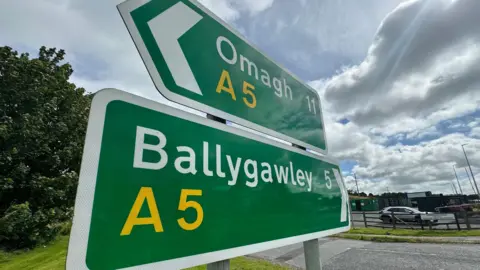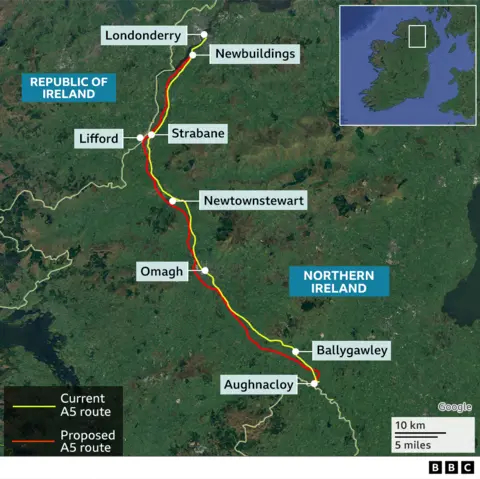A5 dual carriageway now in doubt after legal ruling
 BBC
BBCThe A5 road scheme has been placed in doubt after a judge ruled in favour of a group who oppose the new dual carriageway.
The 58-mile (94km) £1.7bn project was given the green light by Stormont ministers in October last year.
However, on Monday Justice McAlinden ruled the construction of the long-delayed project should not go ahead in its current form, saying the Department for Infrastructure's plans did not comply with climate change targets.
"It is likely that delays in the progression of this scheme will coincide with the occurrence of further loss of life and serious injury," he said.
More than 50 people have died on the A5 since 2006 and campaigners have called for the road to be upgraded.
The scheme was first announced back in 2007, but has been beset by a number of delays.
Justice McAlinden said he was "acutely aware" of how the decision would bring "significant, fresh anguish" to those who have been injured and those who have lost loved ones "as a result of road traffic accidents on the existing A5 road".
"One of the primary justifications for the construction of this new road is that it will be much safer than the existing road," he said.
"However, the decision to proceed with the scheme must be taken in accordance with the law, even if the motivation for doing so is to achieve what is deemed to constitute a clear societal benefit."
The judge said there had been an "inadequacy of information for the purpose of lawful decision making" and this was one of the reasons that the department's decision to go ahead "cannot stand".
Speaking outside the court, Infrastructure Minister Liz Kimmins said it was an "extremely disappointing day".
She said she wanted to pay tribute to "all the families who have lost loved ones on the A5".
"No doubt this will be heartbreaking for each and everyone of them but their campaign will hopefully not go unnoticed and the judge today paid tribute to that," she added.
The judicial review proceedings involved a group of residents, landowners and farmers who mounted a fresh challenge against the decision to begin construction work.
The umbrella group, known as the Alternative A5 Alliance, contended it would breach legislative targets to achieve net-zero greenhouse gas emissions by 2050.
Part of the case centred on the Planning Appeals Commission's recommendations against proceeding with the scheme unless the department was satisfied it would not undermine those goals.
Speaking after Monday's judgement, solicitor Ciaran O'Hare, representing the Alliance, said the group had "never disregarded the safety concerns concerning the current A5 road" and had always argued it should be upgraded "to minimise the adverse effects on the environment and our land".
'Clear a higher bar'
The reach and impact of Stormont's climate change legislation is now clear.
The assembly passed the Climate Change Act in 2022 and up until now much of the controversy around the law has centred on what it means for agriculture - the biggest source of greenhouse gas emissions in Northern Ireland.
The A5 ruling brings road building and other infrastructure projects centre stage.
This judgement does not mean that no new roads can be built. It does mean that ministers will have to clear a higher bar to show that developments will comply with their climate change law.
In 2023 the Welsh government decided to scrap all major road building projects over environmental concerns.
There is no suggestion Stormont ministers will now take the same step, but this ruling may yet lead to policy travelling in a similar direction.
What have those in favour said?

The Enough is Enough group represents families whose relatives have died after crashes on the A5.
Niall McKenna said they were "obviously disappointed" by the decision.
"The judgement acknowledges that this scheme will have major societal benefits," he said.
"So it seems ironic to go against the societal benefits. The law should be there to serve and protect us, not to work against us."
But he added that there were "some positives" in the judgement.
"It does provide a clear and unambiguous roadmap for the scheme to go ahead and we hope that that will happen very quickly," he said.
A man who almost died in a collision on the A5 in 1978 said he was "really upset" by the judgement.
Jim Hunter, from Sion Mills, was so badly injured that police put a sheet over him believing he had not survived.
He said there were so many issues with the A5.
"This stretch of road through Sion Mills is the worst in the country," he said. "Potholes and a really bad surface and there was no sign of that ever getting fixed.
"There's no speed cameras. There's a primary school close by and we've never had an emissions tests done either."
 PA Media
PA MediaWhat else did the judge say?
Justice McAlinden's judgement ran to 97 pages.
"The shortcomings and shortcuts in the decision making highlighted in this judgement are capable of being remedied," he said.
Justice McAlinden made reference to Northern Ireland's draft Climate Action Plan (CAP), which was was published last week.
"There is no specific mention of the proposed new road or its potential impact on climate change objectives and yet it would appear that overall, Northern Ireland may have difficulty staying within the first carbon budget that has now been set," he said.
He added the Department for Infrastructure did not make any reference to the human rights issues raised by the Planning Appeals Commission.
Justice McAlinden's judgement outlined the project will temporarily affect direct access to more than 130 residential properties and will necessitate the demolition of three residential dwellings.
What is the A5?

The A5 is a vital artery of the Northern Ireland road network. More than 58 miles (94km) long, it has more than 200 side roads connecting to it.
The road is single carriageway for most of its length, with overtaking lanes in some sections.
It links Londonderry with Aughnacloy in County Tyrone and passes through towns like Sion Mills, Omagh and Strabane.
It is the main north-south route in the west of Northern Ireland, providing a link between County Donegal and Dublin, via the N2 in County Monaghan.
The road has remained largely unchanged since the 1960s, with the exception of some town bypasses, but there has been a huge rise in the number of cars, lorries and agricultural vehicles using it since it was first built.
Official statistics show there has been about a 10% increase in traffic on the road in the last 10 years alone. An increase of about 30% is forecast over the next 25 years.
How long has the A5 project been in the pipeline?
A plan for a new A5 dual carriageway was first proposed nearly 20 years ago.
It has been at the centre of a raging debate ever since, between those who say a new, modernised road is needed to save lives - and others who worry about the impact on farmland and the environment.
About 1,200 hectares of land, affecting more than 300 working farms would be required for the construction of the full 85km A5 carriageway.
Groups like the Alternative A5 Alliance have repeatedly raised concerns about losing land that has been in their families for generations.
They had called for the existing A5 road to be improved and pointed to the environmental impact of constructing such a large-scale project, as well as unresolved issues about building the new road near potential flood plains.
Meanwhile, police figures have shed light on the cause of crashes on the A5, putting focus on driver responsibility.
Driver error is the most common cause of fatal road traffic accidents on the A5, but it is also the most common cause of fatal accidents on the majority of roads across Northern Ireland.
A previous investigation by BBC News NI found that between 2012 and 2024, the A5 had the highest rate of deaths per kilometre of any road in Northern Ireland.
